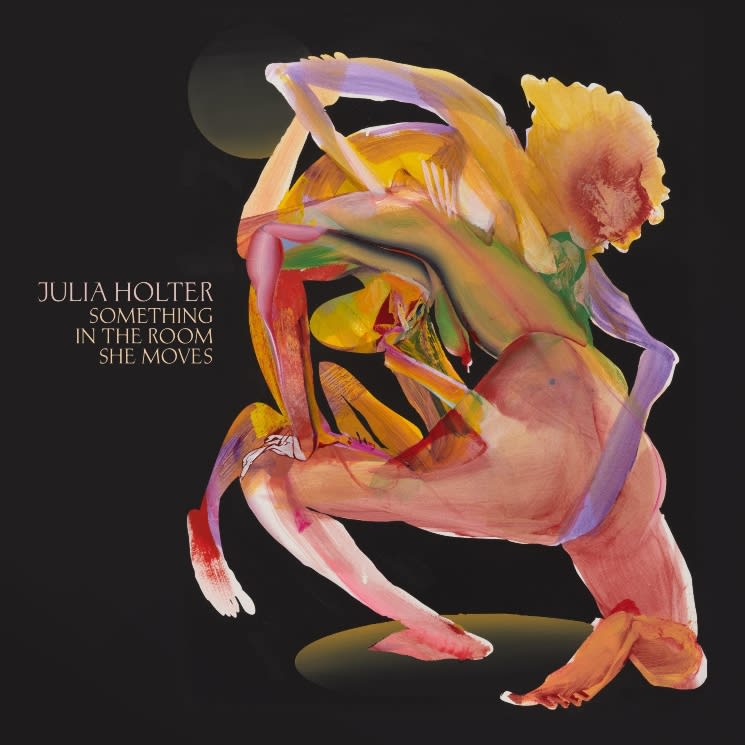One of the most compelling features of Julia Holter's past records is their beautiful contrivance. A staple of Holter's work is a consistent focus on the artifice of art, suffusing her compositions with aesthetic devices borrowed from film, theatre and literature. The benefit of this approach is that Holter's songs are decorated with a rich tapestry of narrative, conceptual and instrumental flourishes, regardless of whether she privileges a pop or avant-garde approach to songwriting.
A potential drawback is a perceived distance between the composer and the composition. Holter's songs are about Greek tragedies, imaginary cities and Renaissance-era social phenomena. They are about Gil Blas, Gigi, Sally, Lucette or Betsy. They are not, at least not immediately, about Holter herself. Something in the Room She Moves closes the gap between conceptual scaffolding and songwriter. This sixth full-length is vulnerable, tender, intimate and some of the most beautiful work of Holter's career thus far.
There's a musique concrète-like quality to many of these songs, with Holter's playful instrumentation, interspersed field recordings and liberal audio processing affirming a commitment to the unbridled wonder of opening a musical toy box and using whatever one finds. The collaged soundscape of album opener "Sun Girl" evokes the cautious exploration of child's play, its sense of deep curiosity further bolstered by warm glockenspiel-like tones, the whistle of woodwinds and what sounds like gentle cooing in the song's bridge. When Devin Hoff's fretless bass enters, it does so like a layer of molasses; rich, sticky and sweet. Hoff's contributions are an essential component of the record, calling to mind the vital role that bass plays in the music of Holter forebearers like Kate Bush or Joni Mitchell.
Perhaps the greatest feat of Something in the Room She Moves is that, while there are plenty of organic instruments all over these recordings, it's the synthesizer playing and sound design that lend the record its characteristic lived-in, sinewy and roving lifeforce. Highlight "Spinning" best summarizes the album's sonic texture, beginning with a tumbling, locomotive beat reminiscent of a train in a children's television show and ending with the warm embrace of de-crescendoing synthesizer pads.
The album's best moments evoke a restless and inquisitive quality, but there's another side of Something in the Room She Moves that is much more still. Tracks like "These Morning," "Materia" and "Who Brings Me" recall the ballads of previous Holter releases and provide some respite from the more spirited instrumentals employed throughout. Compared to the density of "Sun Girl" or "Talking to the Whisper," this collection of sparser, more vocal-oriented songs feels somewhat uneventful at first blush, but repeated and concentrated listens reveal just as much compositional wisdom. "These Morning" features an arresting vocal and woodwind unison melody that opens up effortlessly into an airy refrain, creating a sense of vastness not frequently felt in a collection of songs that privileges nearness instead.
If there is one potential stumbling block on Something in the Room She Moves, it's that the contrast between the busier tunes and those more gentle can sometimes feel unbridgeable, as though the songs don't exist on any identifiable plane together. However, while the songs of Something in the Room She Moves seem to exist in two modes — one buoyant, playful and adventurous, and the other weighty, contemplative and measured — a deeply somatic sense of sound design binds those halves together beautifully. Something in the Room She Moves masterfully evokes a deeply grounding sense of peace, and feels carefully rooted in a commitment to a presence much more immediate than anything Holter has delivered before.
Julia Holter Pulls Us Closer Than Ever on 'Something in the Room She Moves'

BY Tom PiekarskiPublished Mar 21, 2024



